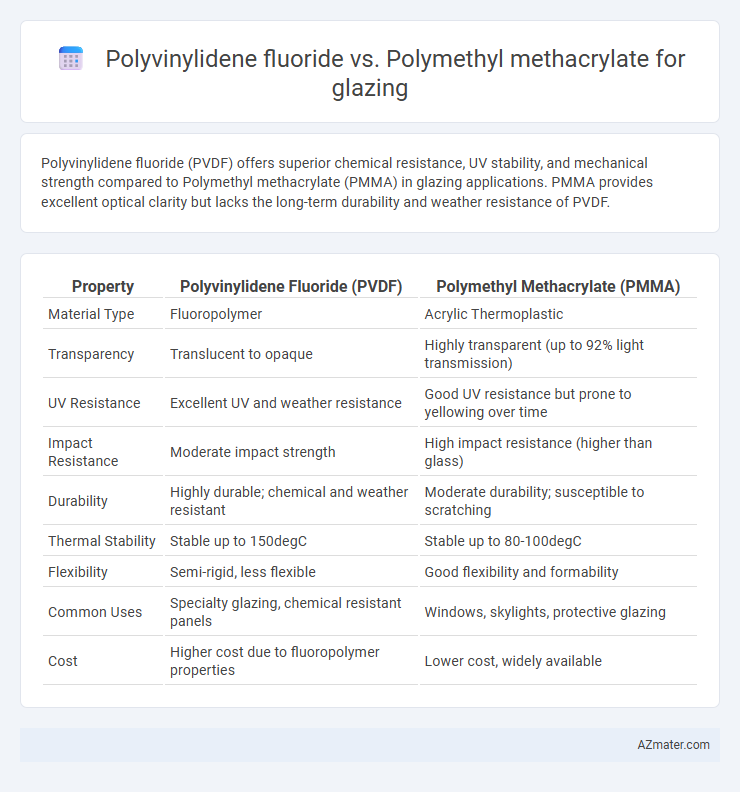Polyvinylidene fluoride (PVDF) offers superior chemical resistance, UV stability, and mechanical strength compared to Polymethyl methacrylate (PMMA) in glazing applications. PMMA provides excellent optical clarity but lacks the long-term durability and weather resistance of PVDF.
Table of Comparison
| Property | Polyvinylidene Fluoride (PVDF) | Polymethyl Methacrylate (PMMA) |
|---|---|---|
| Material Type | Fluoropolymer | Acrylic Thermoplastic |
| Transparency | Translucent to opaque | Highly transparent (up to 92% light transmission) |
| UV Resistance | Excellent UV and weather resistance | Good UV resistance but prone to yellowing over time |
| Impact Resistance | Moderate impact strength | High impact resistance (higher than glass) |
| Durability | Highly durable; chemical and weather resistant | Moderate durability; susceptible to scratching |
| Thermal Stability | Stable up to 150degC | Stable up to 80-100degC |
| Flexibility | Semi-rigid, less flexible | Good flexibility and formability |
| Common Uses | Specialty glazing, chemical resistant panels | Windows, skylights, protective glazing |
| Cost | Higher cost due to fluoropolymer properties | Lower cost, widely available |
Introduction to Glazing Materials
Polyvinylidene fluoride (PVDF) and polymethyl methacrylate (PMMA) serve distinct roles in glazing applications due to their unique properties. PVDF offers superior UV resistance, chemical stability, and durability, making it ideal for architectural facades and exterior glazing. PMMA provides excellent optical clarity and impact resistance, often used in interior glazing or where transparency and light transmission are paramount.
Overview of Polyvinylidene Fluoride (PVDF)
Polyvinylidene fluoride (PVDF) is a high-performance fluoropolymer known for its exceptional chemical resistance, UV stability, and mechanical strength, making it ideal for architectural glazing applications. PVDF coatings provide long-lasting color retention and weatherability, outperforming polymethyl methacrylate (PMMA) in durability and resistance to environmental degradation. Its superior dimensional stability and resistance to corrosion ensure enhanced protection and aesthetic appeal in external glazing systems.
Overview of Polymethyl Methacrylate (PMMA)
Polymethyl methacrylate (PMMA) is a transparent thermoplastic widely used for glazing applications due to its excellent optical clarity, high impact resistance, and UV stability. PMMA offers superior weather resistance and lighter weight compared to glass, making it ideal for windows, skylights, and protective barriers. Its ease of fabrication, including thermoforming and cutting, enhances versatility in architectural and automotive glazing solutions where durability and aesthetics are essential.
Key Physical Properties: PVDF vs PMMA
Polyvinylidene fluoride (PVDF) offers superior chemical resistance, UV stability, and durability compared to polymethyl methacrylate (PMMA), making it ideal for long-term glazing applications exposed to harsh environments. PMMA excels in optical clarity and impact resistance but degrades faster under prolonged UV exposure and chemical stress relative to PVDF. PVDF's high tensile strength, low moisture absorption, and excellent weatherability outperform PMMA's lower tensile strength and higher susceptibility to weathering in exterior glazing uses.
Durability and Weather Resistance Comparison
Polyvinylidene fluoride (PVDF) offers superior durability and weather resistance for glazing applications compared to Polymethyl methacrylate (PMMA), with enhanced resistance to UV radiation, chemical exposure, and extreme temperature fluctuations. PVDF coatings maintain their color stability and structural integrity over extended periods, making them ideal for harsh outdoor environments. In contrast, PMMA, while optically clear and lightweight, tends to yellow and degrade faster under prolonged exposure to sunlight and harsh weather conditions.
Optical Clarity and Light Transmission
Polyvinylidene fluoride (PVDF) offers excellent optical clarity and high light transmission, making it ideal for glazing applications where durability and UV resistance are critical. Polymethyl methacrylate (PMMA) provides superior optical transparency and greater light transmission rates, often exceeding 92%, which is comparable to glass and preferred for aesthetic glazing solutions. While PVDF excels in chemical resistance and weatherability, PMMA is favored for maximum clarity and smooth surface finish in architectural glazing.
Chemical Resistance and Maintenance
Polyvinylidene fluoride (PVDF) exhibits superior chemical resistance compared to Polymethyl methacrylate (PMMA), making it ideal for glazing in harsh environments with exposure to solvents, acids, and alkalis. PVDF surfaces require minimal maintenance due to their non-stick properties and resistance to UV degradation, reducing cleaning frequency and costs. PMMA, while offering good optical clarity, is more susceptible to chemical attack and surface scratches, necessitating more frequent upkeep to maintain appearance and performance.
Thermal and UV Performance
Polyvinylidene fluoride (PVDF) exhibits superior thermal stability with a melting point around 177degC, making it highly resistant to heat deformation compared to polymethyl methacrylate (PMMA), which has a lower glass transition temperature near 105degC. PVDF offers exceptional UV resistance due to its fluoropolymer composition, maintaining clarity and mechanical properties under prolonged solar exposure, whereas PMMA, though initially UV transparent, tends to yellow and degrade faster without protective coatings. This makes PVDF more suitable for glazing applications demanding durability in high-temperature and intense UV environments.
Applications in Architectural Glazing
Polyvinylidene fluoride (PVDF) is prized in architectural glazing for its exceptional weather resistance, high durability, and self-cleaning properties, making it ideal for exterior facades and curtain walls. Polymethyl methacrylate (PMMA), commonly known as acrylic, offers superior optical clarity and impact resistance, preferred for skylights, canopies, and decorative glazing where light transmission and aesthetics are critical. PVDF coatings enhance aluminum frames and glass surfaces by providing UV stability and color retention, whereas PMMA is often chosen for lightweight, transparent glazing solutions with high visual appeal.
Cost Analysis and Sustainability Considerations
Polyvinylidene fluoride (PVDF) offers superior durability and weather resistance compared to Polymethyl methacrylate (PMMA), resulting in lower long-term maintenance costs despite higher initial investment. PMMA provides a cost-effective solution with lower upfront expenses and ease of fabrication but may require more frequent replacement due to susceptibility to UV degradation and impact damage. Sustainability considerations favor PVDF for its longer lifecycle and recyclability, whereas PMMA's shorter lifespan contributes to increased environmental impact through more frequent material turnover.

Infographic: Polyvinylidene fluoride vs Polymethyl methacrylate for Glazing
 azmater.com
azmater.com